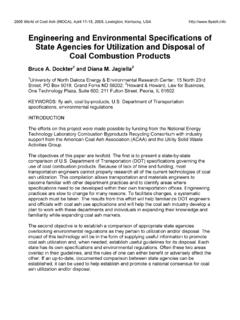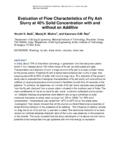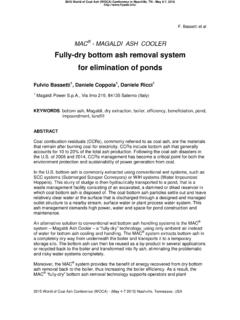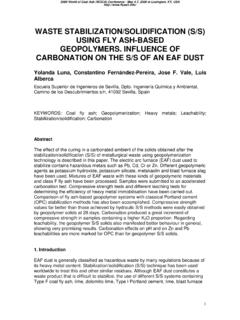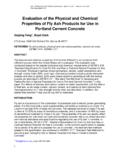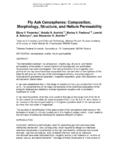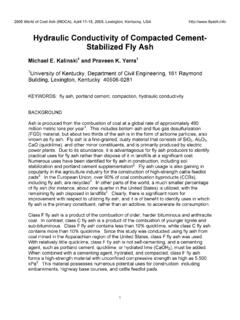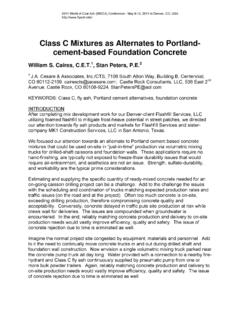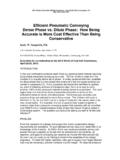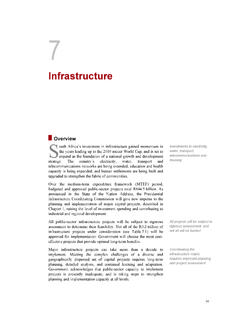Transcription of Historical Development of Coal Ash Utilisation in South Africa
1 Historical Development of Coal Ash Utilisation in South Africa Richard A Kruger1 and Japie E Krueger2 1R&D Manager, Ash Resouces (Pty) Ltd; 2 Building Materials Science and Technology Consultant KEYWORDS: research management, cement, concrete, plastics, agriculture, marketing, sales INTRODUCTION The South African fly ash industry developed in a unique, somewhat different manner to similar industries elsewhere in the world. Recognising the ash opportunity, the research community provided the fundamental science and technology for sustainable ash applications well before either the power generators or cement and construction industries realised the value of coal ash. In coordinating their efforts and cooperating closely with each other various universities and research organisations ensured an effective unified approach that soon drew the attention, and ultimate involvement of industry.
2 This paper explains the scenario against which these developments took place that saw commercial ash sales rise from a few thousand tons in the 1980s to approaching 2,0 million tons today (2005). THE POWER SCENE The rapid industrial expansion within South Africa during the late 1970s and early 80s created a sudden surge in the demand for electricity. Given the vast coal reserves the additional capacity was provided by the erection of large (3000-3600 MW) pulverised coal-fired power stations. These stations, situated at the mine itself, utilised coal of relatively low calorific value and high ash content which resulted in vast quantities of coal ash (3-6 million tons) arising at individual power stations. The availability of inexpensive land at the mine enabled low-cost disposal of the coal ash.
3 The power stations, were located a significant distance (100-250 miles) from the economic hub of the country and very far away (300-1100 miles) from other centres of industrial activity along, and adjacent to the coast. Being remote, public pressure to minimise the aesthetic and environmental impact of these dumps was muted. The South African fly ash industry was thus born with a connotation of huge mountains of waste of little or no value. 2005 World of Coal Ash (WOCA), April 11-15, 2005, Lexington, Kentucky, 2 Even where large-scale uses such as the backfilling of mines or structural fills for roads existed the economics of transport mitigated against usage. RESEARCH PROGRAMME MANAGEMENT Recognising their responsibility in investigating the ash problem governmental research-funding agencies launched a nationally coordinated programme under the auspices of the Cooperative Scientific Programmes, the forerunner of the current National Research Foundation (NRF).
4 The funding was used to support both fundamental (university) as well as applied (CSIR and Mintek). The aim being to provide the scientific and technical information needed to fully exploit the resource potential of coal ash. The driving force behind the Development of the South African ash industry was one that required the ash be transformed from a waste to a product of technical and commercial value so that it could bear the cost of long distance transport and still be an economically viable resource. The organisational structure utilised to evaluate the relevance of both solicited and unsolicited proposals needed to be objective. A two-tier committee system was used; an evaluation mechanism (advisory committee) was put in place to consider the potential value of the research proposal to the programme objectives, peer evaluation of participants, contribution to training and Development of students and funding needed.
5 This advisory committee was drawn from academics, research managers both in the private and public sector as well as consultants. The funding was allocated by an independent national committee. Initially, all funding was provided by the government but within two years many industrial firms were contributing either by auxiliary funding or sharing their in-house research findings. The structure of the coordinated programme facilitated and encouraged industrial involvement which in turn provided a unique focus and ensured seamless technology transfer. Industry was relatively quick in implementing technology where it made techno-economic sense. Identifying the necessity of beneficiating and processing the ash in order to carefully adapt its performance characteristics to meet the needs of the marketplace was perhaps industry s most significant contribution.
6 The precursory research and Development therefore focussed on developing specific performance products rather than aiming to maximise volumes used. SCOPE OF RESEARCH The research activities were widespread. Initially, all the sources of coal ash were characterised, chemically, mineralogically and morphologically. 3 Armed with this information a plethora of potential applications were investigated. These included recovery of alumina, soil amelioration, waste immobilisation, refractories, clay bricks, road stabilisation, processing aids and fillers for polymers, zeolites, counteracting acid mine drainage, mine backfilling, functional fillers for rubbers and of course, the very backbone of the industry; usage in cement, concrete and allied products. Some of the findings, highlights and commercial applications that ensued during and subsequent to the lifetime of the programme (7 years) bears mentioning.
7 FLY ASH AS A CEMENT EXTENDER The initial characterisation of all the sources of ash in South Africa established that the ash was high in alumina and silica, with moderate amounts of calcia and iron, and low in alkalis. Power stations like Matla, Kendal and Lethabo were found to produce fly ash with exceptional pozzolanic characteristics. This was due to the particular way in which the power stations operated. The combustion technology employed at these stations required careful control in order to maximise energy recovery from the low-grade high-ash (30-40%) coal being supplied by the mine. The result was a consistent fly ash, low in carbon with a significant amount of amorphous phase - a typical pozzolan. Indeed initial tests in cement and concrete confirmed the pozzolanic potential of South African fly ash.
8 In its raw state the fly ash, although of good quality, did not improve the performance of concrete to such an extent as to justify the cost of transportation over long distances. It was thus necessary to add value to the fly ash in order to enable transport to the market place and ensure a long-term economically viable and sustainable industry. The amount of fly ash available in South Africa (20 million tons) significantly exceeds cement clinker capacity (10 million tons). Driven by the need to enhance the properties of fly ash the finer more reactive fraction was initially recovered from the last 3 fields of the array of electrostatic precipitators. Work on this product soon confirmed that it was an excellent pozzolan that, albeit variable, enhanced concrete performance. As news of these findings by the research community reached the building and construction industry, ash became more widely investigated, its benefits quickly appreciated and its Utilisation implemented.
9 Demand grew rapidly and it was soon apparent that reliance upon a product selected from the precipitators was inadequate both from a volume and consistency point of view. It was therefore decided to install equipment to beneficiate the fly ash by air classification. A plant was commissioned in the early eighties (Matla) with a capacity of about 250 000 tons. The site was selected on the grounds of the fundamental chemical and physical properties of the ash as published by the members of the coordinated research programme. An air classified fly ash with 90% below 45 m 4and a carbon content of less than 1% became the industry norm (SABS 1491-2.). The coarse fraction was disposed to the dump in conjunction with the ash not used. This station produces about 3 million tons of fly ash annually.
10 As participation in the programme became more widespread it was soon established that classified fly ash was eminently suitable for cement extension since it is: spherical pozzolanic low in alkalis non-expansive of consistent quality and reactivity; and the carbon content is low The effect of the abovementioned properties is that less water is required to make concrete. This results in less shrinkage (cracking), improved density and easier placing. The low carbon meant that mineral admixtures used to modify concrete behaviour (delay setting, aid flow etc) are not affected by fly ash. The pozzolanicity of the fly ash means that the ultimate strength of the concrete exceeds that of portland cement only concrete. Contractors soon started using innovative concrete mix designs to produce equivalent strength concrete with less cement.
